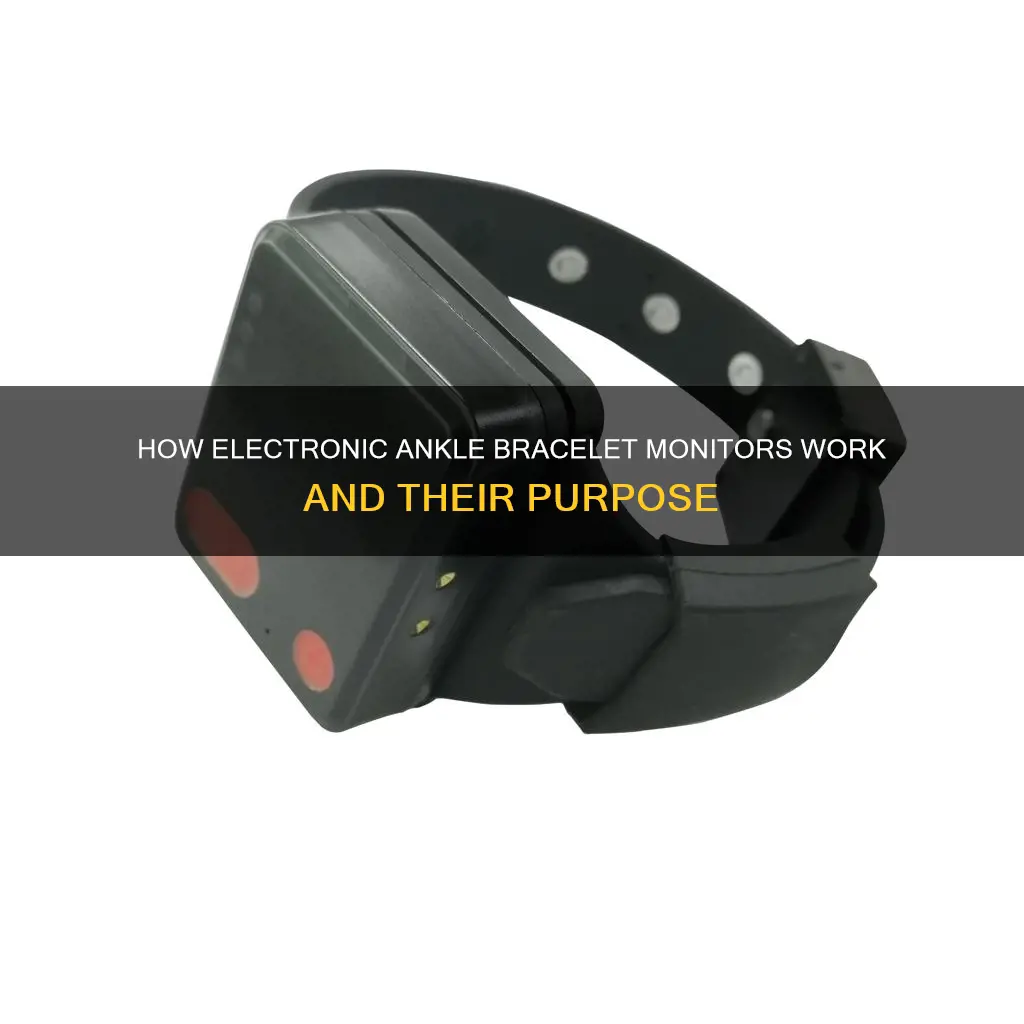
An electronic ankle bracelet monitor is a device affixed to a person's body, typically around the ankle, as a form of surveillance. These devices have been used in recent years as a way to allow people to live in their homes instead of serving time in jail. They are used to track the movements and activities of defendants awaiting trial and convicted offenders on parole or probation. Ankle bracelet monitors use GPS and RF technology to track someone's location in real time and report this information to authorities. If the wearer enters a predetermined excluded area, the device will alert the supervising agency.
| Characteristics | Values |
|---|---|
| Purpose | Monitor a geographical special condition |
| Type of technology | GPS, RF, A-GPS, GLONASS |
| Use | Monitor movements and activities of defendants awaiting trial and convicted offenders on parole or probation |
| Alcohol monitoring | Detect alcohol consumption through sweat |
| Alert system | Alert supervising agency if the wearer enters a pre-determined excluded area |
| Payment | The wearer pays for the device, with fees ranging from $5 to $25 a day |
| Comfort | Some people have reported skin irritations |
| Permanence | In many states, people convicted of certain crimes must wear the device for life |
| Medical procedures | May not be administered if a person is wearing the device |
| Landline | Requires a landline phone, which can add an additional cost |
| Data storage | Data is transmitted to a monitoring centre |
| Alert system | Alerts authorities if the wearer tampers with the device |
What You'll Learn

How does an electronic ankle bracelet monitor work?
An electronic ankle bracelet monitor is a GPS-enabled tracking device that attaches to the ankle of a person subject to geographic restrictions while on bail or following release from prison. They are used by every state in the US, as well as the federal government, to monitor the movements and activities of defendants awaiting trial and convicted offenders currently on parole or probation.
Electronic ankle bracelet monitors work by using GPS and RF technology. GPS, or Global Positioning System, is similar to the navigation system in a car and allows the bracelet to continuously track someone in real-time and report the information to authorities. RF, or radio frequency, technology is used for short-range monitoring and can be used to monitor the presence or absence of the wearer from an exact location. This type of bracelet is primarily used for those under house arrest or under a curfew.
In the case of GPS monitoring, if the person wearing the bracelet enters a pre-determined excluded area, the device will alert the supervising agency. Monitors can be configured to include "exclusion zones" that trigger an alarm if a subject crosses a geographical boundary and enters a restricted location. The data from the ankle bracelets are transmitted to a monitoring centre, where software allows for real-time monitoring of subjects, managing alerts, and other features.
For RF monitoring, the bracelet will communicate using RF when in proximity to the base station and will rely solely on RF to communicate through the home station. If the bracelet moves out of range, it will re-enable GSM and GPS for localisation and telecommunication.
Install ASUS Monitor WHQL Driver: Easy Step-by-Step Guide
You may want to see also

Who uses electronic ankle bracelet monitors?
Ankle bracelet monitors are used by people who are subject to geographic restrictions while on bail or following release from prison. They are also used by people who are under house arrest.
In some jurisdictions, an electronic tag fitted above the ankle is used for people as part of their bail or probation conditions.
In British Columbia, Canada, the use of ankle bracelets has surged in recent years, especially during the COVID-19 pandemic. This increase was due to concerns about the spread of the virus in prisons, which led to more people being released with conditions.
Ankle bracelets are also used in healthcare settings and in immigration contexts. For example, in June 2022, the British Home Office announced a pilot program to track migrants who arrived by boat using GPS devices.
Ankle bracelet monitors are typically used to monitor high-risk offenders, such as those who have committed violent crimes, sex crimes, or domestic violence. They can also be used to monitor people who have been released from prison under a supervision order, as in the case of Randall Hopley, a high-risk sex offender in Canada who was required to wear an ankle bracelet after being released from prison.
In addition to monitoring offenders, ankle bracelet monitors can also be used to protect vulnerable individuals. For example, they can be used to track the location of elderly individuals with dementia who may wander away and become lost.
Upgrading to a 144Hz Monitor: Worth It With a 1060?
You may want to see also

What are the benefits of electronic ankle bracelet monitors?
An electronic ankle bracelet monitor is a GPS-enabled tracking device that attaches to the ankle of a person subject to geographic restrictions while on bail or following release from prison. The use of these devices has surged in recent years, especially during the COVID-19 pandemic, as a means to reduce prison populations.
Cost-Effectiveness:
Electronic monitoring (EM) has been shown to be cost-effective for criminal justice agencies and society. A study by the District of Columbia Crime Policy Institute found that EM reduced per-participant costs to local agencies by $580 and saved federal agencies $920 on average. The reduced recidivism rates also generate societal benefits, as the average number of arrests prevented per participant is estimated to generate $3,800 in societal benefits.
Reduced Prison Populations and Recidivism:
EM supports the transition from incarceration to community integration. Individuals on EM may serve a portion of their sentence outside of prison, reducing prison populations. Scientific studies have shown that EM helps reduce an individual's chances of returning to jail. A 2020 study published in the Journal of Criminal Justice concluded that EM "has been shown to produce positive effects for certain offenders (such as sex offenders) [...] and perhaps in combination with other conditions attached (such as geographic restrictions) and therapeutic components."
Enhanced Community Safety:
EM can be an effective alternative to incarceration, particularly for community corrections. It allows officers to supervise high-risk clients more effectively while they are in the community, which can enhance public safety.
Accountability and Compliance:
EM is a tool used to promote accountability and compliance among individuals who are on bail, probation, or parole. It helps ensure that individuals adhere to the conditions of their release, such as curfews and geographic restrictions.
Deterring Crime:
The use of ankle bracelets and other electronic monitoring devices has been found to be effective in deterring crime and reducing the likelihood of absconding. A study of 75,661 Florida offenders placed on home detention from 1998 to 2002 found that those with electronic tagging were 91.2% less likely to abscond and 94.7% less likely to commit new offenses compared to unmonitored offenders.
While electronic ankle bracelet monitors offer these benefits, it is important to acknowledge that they have also faced criticism and concerns related to issues such as privacy, human rights, and the potential for stigmatization.
Finding the Oil Life Monitor in a 2008 Ford Edge
You may want to see also

What are the drawbacks of electronic ankle bracelet monitors?
Ankle bracelet monitors are a form of surveillance that uses an electronic device affixed to a person. They are often GPS-enabled tracking devices that attach to the ankle of a person subject to geographic restrictions while on bail or following release from prison. They are used to monitor a person's compliance with court-ordered conditions, such as home curfews or restrictions on entering certain areas or approaching particular people. While these monitors are intended to promote accountability and compliance, there are several drawbacks to their use.
One drawback is that ankle bracelet monitors do not physically restrain the wearer from leaving a designated area or prevent them from re-offending. This means that dangerous offenders may still be able to commit crimes before authorities can intervene. Additionally, the conditions of home detention with electronic monitoring may be perceived as too lenient by victims and the public, potentially leading to concerns about the effectiveness of the monitoring in deterring crime.
Another disadvantage is the potential for human error or technical issues. For example, there may be delays in how long it takes for information about an offender's location to be passed on to the police or corrective services. In some cases, there may be a lag of several days between a breach of conditions (such as missing a curfew) and the notification of the relevant authorities. Furthermore, offenders may be able to tamper with their devices, and there may be GPS dead zones, particularly in geographically vast areas.
The use of ankle bracelet monitors also raises serious civil liberty and ethical concerns. The constant surveillance of individuals, particularly through devices fixed to their bodies, can be seen as an invasion of privacy and a restriction on freedom of movement. The potential for civil liberty infringements is further heightened by the development of miniature tracking devices that can be implanted beneath the skin, allowing for continuous monitoring of an individual's location and even their physiological signs.
Finally, the use of ankle bracelet monitors may have negative psychological impacts on the wearer. While it allows individuals to maintain employment and family relationships, the constant monitoring and potential stigma associated with the device can be psychologically wearing and onerous.
Understanding Monitor Resolution: Know Your Display Definition
You may want to see also

What is the future of electronic ankle bracelet monitoring?
The future of electronic ankle bracelet monitoring is likely to be influenced by several factors, including technological advancements, ethical considerations, and changing societal needs.
Technological advancements will play a significant role in shaping the future of electronic ankle bracelet monitoring. The devices are expected to become even more compact, lightweight, and cost-effective. Improvements in GPS and RF technology will enhance location accuracy and real-time tracking capabilities, making it easier to monitor offenders' movements and ensure compliance with geographical restrictions. Additionally, the development of hybrid monitoring modes, such as combining GPS with RF technology, will provide greater flexibility and reliability in tracking individuals.
However, there are also ethical considerations that will impact the future of electronic ankle bracelet monitoring. Critics argue that the technology can lead to a form of "e-carceration," where individuals are subjected to digital incarceration and face incarceration for minor technical violations or false alarms. There are also concerns about the financial burden placed on those wearing the devices, as private companies often charge high fees for the surveillance service. This has led to calls for less restrictive alternatives, such as court reminders and transportation assistance, which may gain traction in the future.
The changing societal needs, particularly regarding public safety and criminal justice reform, will also shape the future of electronic ankle bracelet monitoring. On the one hand, the technology offers an alternative to incarceration, helping to reduce prison populations and associated costs. On the other hand, there are concerns about the potential for over-surveillance and the disproportionate impact on marginalized communities, especially people of color. As a result, the future may see a greater emphasis on balancing public safety with individual freedoms and addressing systemic inequities.
In conclusion, the future of electronic ankle bracelet monitoring will likely involve continued technological advancements, ongoing debates about ethical considerations, and a re-evaluation of the role of such technology in criminal justice and public safety. The goal will be to strike a balance between effective monitoring and the protection of civil liberties, ensuring that electronic ankle bracelet monitoring serves its intended purpose without infringing on the rights and well-being of those subjected to it.
Ways to Check if Your Monitor Boasts 120Hz Refresh Rate
You may want to see also
Frequently asked questions
An electronic ankle bracelet monitor is a device worn around the ankle that is used to track the movements of an individual. It is often used for people who are out on bail, on probation, or following a prison release.
Ankle bracelet monitors use GPS technology to track someone's location in real time and report this information to authorities. They can also be configured with exclusion zones that trigger an alarm if the wearer enters a restricted area.
In the US, every state and the federal government use ankle bracelet monitors to track defendants awaiting trial and convicted offenders on parole or probation. They are also used in other countries, such as Canada and Brazil.
Electronic ankle bracelet monitors can help reduce prison populations and the risk of COVID-19 in prisons. They can also provide peace of mind to victims of crimes by alerting them if the offender enters their proximity.
Some concerns include the cost of the device, which is often paid for by the wearer, and the potential for skin irritation. There are also privacy concerns about who has access to the tracking information.







